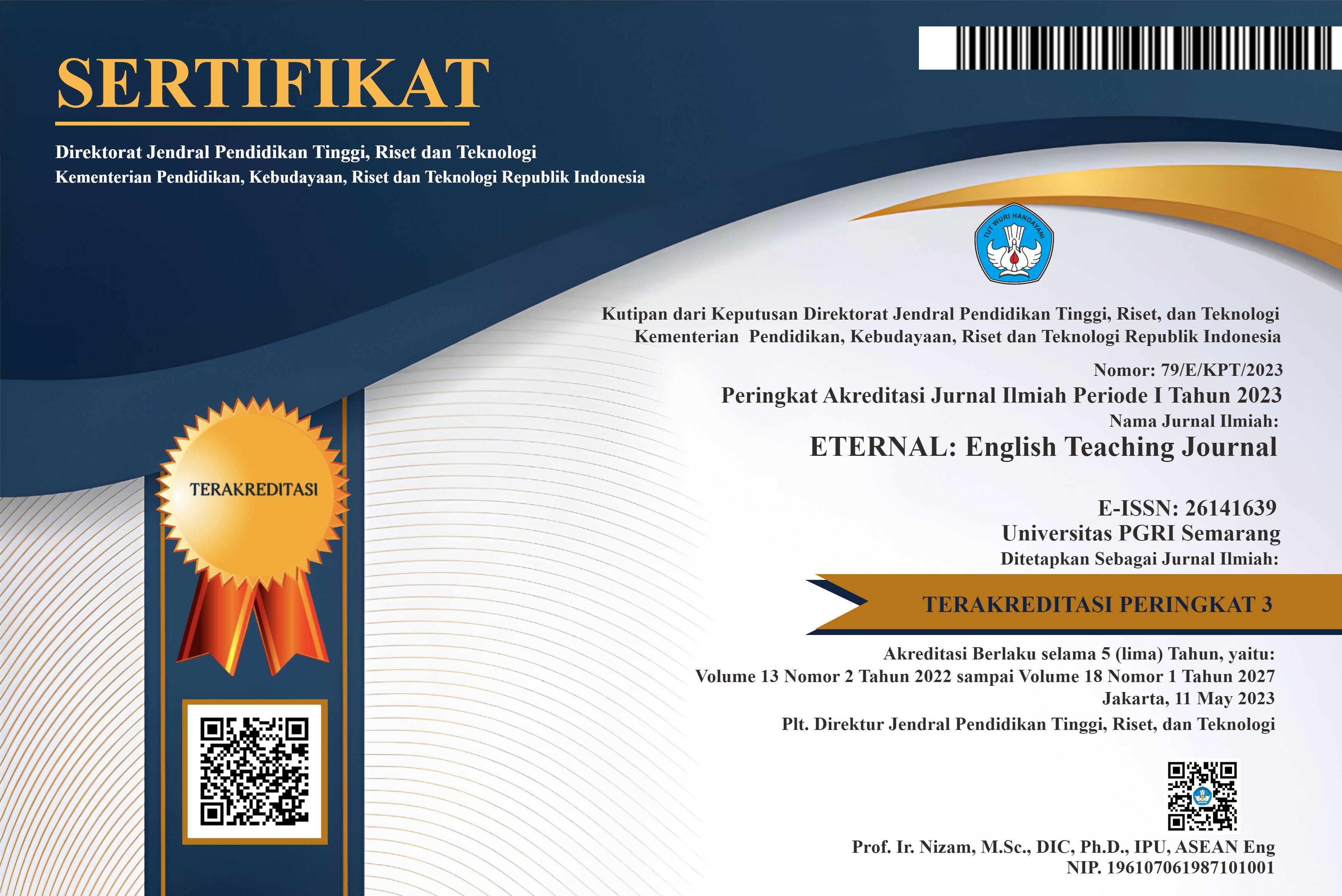Bridging the Gap between Differentiated Instruction and Second Language Acquisition among University Students
DOI:
https://doi.org/10.26877/eternal.v16i1.1109Keywords:
Differentiated Instruction, Second Language Acquisition, Teaching Strategies, Individual DifferencesAbstract
Second Language Acquisition (SLA) has drawn considerable attention from researchers and educators seeking effective strategies to enhance language learning. One such approach that has gained traction is differentiated instruction which may be effective in enhancing students' second language acquisition process. To address this, a qualitative case study was conducted to examine the impact of differentiated instruction on students' second language (L2) acquisition. The study involved 15 participants who had undergone an English-intensive program at the university level. Data were collected through online open-ended questionnaires designed to capture cognitive, affective, and conative impacts. The findings reveal that differentiated instruction aligned with students' interests and abilities significantly enhances students' understanding, motivation, and active learning behaviors in their second language acquisition process. However, the study also identified challenges, including difficulties with independent acquisition and intrinsic motivation barriers. Future research should explore the long-term impacts of this research and develop strategies to address the identified challenges, ensuring a broader impact on student second language acquisition.
References
Amir, M. T. (2015). Merancang Kuesioner: Konsep dan Panduan Untuk Penelitian Sikap, Kepribadian, dan Perilaku. Prenada Media.
Bidari, S. (2021). Nepalese EFL Teachers’ Insight and Practices of Differentiated Instruction. The European Conference on Education. https://doi.org/10.22492/issn.2188-1162.2021.41
Brown, H. D. (2001). Teaching by Principle and Interactive Approach to Language Pedagogy. Longman.
Changyu, L. (2009). A Research on Second Language Acquisition and College English Teaching. English Language Teaching, 2. https://doi.org/10.5539/elt.v2n4p57
Chen, J.-H., & Chen, Y.-C. (2017). Differentiated Instruction in a Calculus Curriculum for College Students in Taiwan. Journal of Education and Learning, 7, 88. https://doi.org/10.5539/jel.v7n1p88
Dağyar, M., & Demirel, M. (2015). Effects of Problem-Based Learning on Academic Achievement: A Meta-Analysis Study. TED EĞİTİM VE BİLİM, 40(181). https://doi.org/10.15390/EB.2015.4429
Demirel, M., & Dağyar, M. (2016). Effects of Problem-Based Learning on Attitude: A Meta-analysis Study. Eurasia Journal of Mathematics, Science and Technology Education, 12(8), 2115–2137. https://doi.org/10.12973/eurasia.2016.1293a
Dörnyei, Z. (2009). Individual Differences: Interplay of Learner Characteristics and Learning Environment. Language Learning, 59(s1), 230–248. https://doi.org/https://doi.org/10.1111/j.1467-9922.2009.00542.x
Fook, C. Y., & Sidhu, G. K. (2010). Authentic Assessment and Pedagogical Strategies in Higher Education. Journal of Social Sciences, 6, 153–161. https://doi.org/10.3844/jssp.2010.153.161
Fox, P., Guinee, T., Cogan, T., & McSweeney, P. (2017). Fundamentals of Cheese Science. In Fundamentals of Cheese Science, Second Edition. https://doi.org/10.1007/978-1-4899-7681-9
Gregory, Gayle., & Chapman, C. (2013). Differentiated Instructional Strategies : One Size Doesn’t Fit All (3rd Edition). Corwin Press.
Idamayanti, R., Nurhidayah, & Ashar. (2022). Penyusunan Rencana Pelaksanaan Pembelajaran Berdiferensiasi di SMP Negeri 4 Pangkajene di Kabupaten Pangkajene dan Kepulauan. Seminar Nasional Paedagoria, 2.
Ismail, S. (2019). Impact of Differentiated Instruction on the Writing Process of ESL Learners. ELF Annual Research Journal, 21(1), 130–153.
Kotob, M., & Arnouss, D. (2019). Differentiated Instruction: The Effect on Learner’s Achievement in Kindergarten. International Journal of Contemporary Education, 2(2), 61. https://doi.org/10.11114/ijce.v2i2.4479
Krashen, S. D. (1985). The Input hypothesis: Issues and implications. Longman.
Krashen, S. D. (1989). Principles and Practice in Second Language Acquisition. Elsevier Science & Technology.
Mayo, M. del P. G., & Pica, T. (2000). Interaction among Proficient Learners: Are Input, Feedback and Output Needs Addressed in a Foreign Language Context? Studia Linguistica, 54, 272–279. https://doi.org/10.1111/1467-9582.00066
Mirawati, I. G. A., Suwastini, N. K. A., Haryanti, N. D., & Jayantini, I. G. A. S. R. (2022). Differentiated Instructions: Relevant Studies on Its Implementation. Prasi, 17(1), 11–21. https://doi.org/10.23887/prasi.v17i1.41867
Naka, L. (2017, October 28). The Importance of Differentiated Instruction in EFL Learning. UBT International Conference. https://doi.org/10.33107/ubt-ic.2017.119
O’Grady, W. (2008). The Emergentist Program. Lingua, 118, 447–464. https://doi.org/10.1016/j.lingua.2006.12.001
Ojong, A. S. (2023). Unraveling the Efficacy of Differentiated Instruction in Enhancing Second Language Acquisition: A Comprehensive Review and Future Directions. International Journal of Linguistics, Literature and Translation, 6, 75–82. https://doi.org/10.32996/ijllt.2023.6.6.8
Pasroni, N. (2023). Analysis of the Effectiveness of Differentiated Instruction in Improving Student Well-Being in Grade VII Social Studies Learning at SMA Negeri 1 Tegalsari. Sibatik Journal, 2(10). https://doi.org/10.54443/sibatik.v2i10.1415
Pekrun, R., Frenzel, A., Goetz, T., & Perry, R. (2007). The Control-value Theory of Achievement Emotions: An Integrative Approach to Emotions in Education. Publ. in: Emotion in Education / Ed. by Paul A. Schutz and Reinhard Pekrun. Amsterdam : Academic Press, 2007, Pp. 13-36.
Reis, S., Mccoach, D. B., Little, C., Muller, L., & Kaniskan, R. (2011). The Effects of Differentiated Instruction and Enrichment Pedagogy on Reading Achievement in Five Elementary Schools. American Educational Research Journal - AMER EDUC RES J, 48(2), 462–501. https://doi.org/10.3102/0002831210382891
Saville-Troike, M. (2012). Introducing Second Language Acquisition. Cambridge University Press.
Spada, N., & Lightbrown, P. M. (2022). In it Together: Teachers, Researchers, and Classroom SLA. The Modern Language Journal, 106(3), 635–650. https://doi.org/https://doi.org/10.1111/modl.12792
Stefánsson, E. (2013). Second Language Acquisition: The Effect of Age and Motivation. https://api.semanticscholar.org/CorpusID:142560814
Tomlinson. (2017). Differentiated Instruction in Academically Diverse Classrooms (3rd Edition). ASCD.
Tomlinson, C. A. (2014). Classroom Responding to the Needs of All Learners 2nd Edition. ASCD. www.ascd.org/deskcopy.
Tomlinson, C. A., & Imbeau, M. (2010). Leading and Managing a Differentiated Classroom. In ASCD. ASDC.
Tomlinson, C. A., & Moon, T. R. (2013). Assessment and Student Success in a Differentiated Classroom. www.ascd.org/memberbooks







